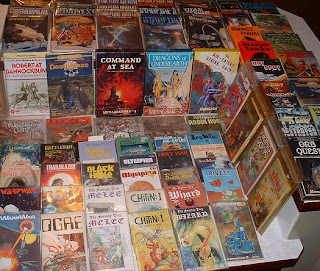 I mentioned somewhere, not sure if it was here or in the comments on another blog, that I have a fairly extensive collection of microgames. Here is some of my collection.
I mentioned somewhere, not sure if it was here or in the comments on another blog, that I have a fairly extensive collection of microgames. Here is some of my collection.Microgames first came out when I was in middle school. They were great for a quick game during lunch, or if you were going over to a friend's house for a couple of hours after school.
The Fantasy Trip: Melee and Wizard were played frequently. After that, the other two games we preferred playing were Deathmaze (by SPI) and Starfire (by Task Force Games).
Deathmaze was a lot of fun, as it was a rules-light Dungeon-crawl, where the dungeon was built out of "chits" containing rooms and corridors, that were revealed, one at a time, as you made your way through the dungeon. The characters and monsters were also chits, and all the stats were printed on the chit. I think it was designed for solitary play, but we would take turns revealing the map-chits, and someone would play out the tactics of the monsters.
Starfire was a great game as well. Starfire was a sci-fi combat game, that used some very simple game mechanics for movement and combat. Each spaceship was made up of a "character string", with each letter or number in the string representing a different structure or ability that the spaceship possessed.
For example, a small frigate might have the following character string: SSAAPXIII
In the example above, Armor was represented by the letter "A". So if you had 2 units of Armor, your ship would have two As in the character string. The letter "I" represented Ion Drives, and the larger your ship was, the more Ion Drives you needed to propel the spaceship at high speeds.
As you took damage, you would mark off the damage, from left to right, so you always wanted to put your shields and armor at the start of the character string. Well, that's not entirely true: there were beam and other weapons that could skip past the front and attack internal systems, but the kinetic weapons usually did damage from left to right.
While Starfire (and the follow-up game, Starfire II) had a set of pre-designed encounters, they also had rules for designing your own ships and playing out your own battles.
We played most of the other games at least once, and occasionally played Ogre and Starfleet Battles, but our go-to micro-games were The Fantasy Trip, Deathmaze and Starfire. They just seemed to have the most re-play value.
2 comments:
That Starfire system sounds very inspired. It totally tweaks my programmer "elegance" appreciation.
Innovations like that just don't(ok almost never) appear in "real" games that have hundreds of pages to pour rules into.
That was the great thing about the micro-game lines. The requirements of the microgame design philosophy forced the game designers to make the simplest game they could, while still providing a rich gaming experience.
Several of those micro-games (Starfleet Battles, Starfire, Ogre, Hitlers War, The Fantasy Trip) were so good, that they were turned into boxed sets, multi-tome book lines, and multi-accessory games.
After Starfire and Starfire II were published, they published Starfire III, which was a multi-player economic anbd military wargame spanning the stars.
Like most games today, the microgame designers take a great idea, and if it is successful, they pile supplement after supplement onto it, until it collapses under its own weight.
Post a Comment